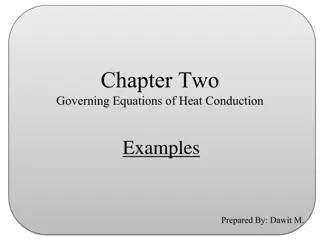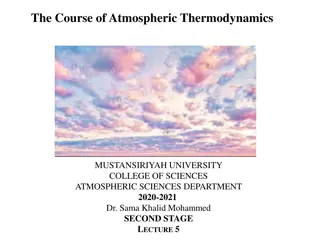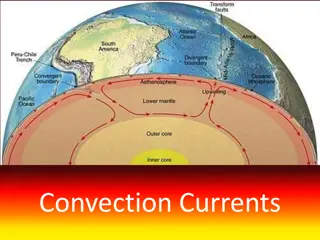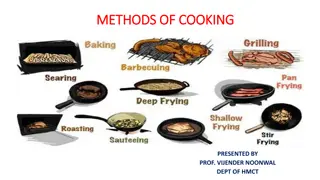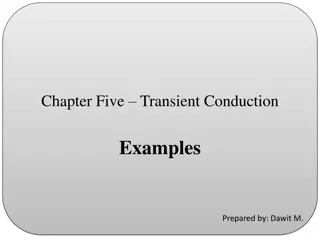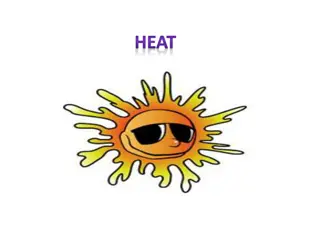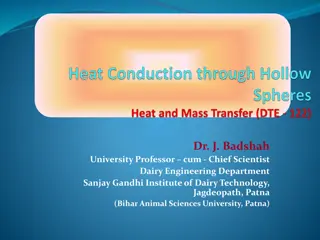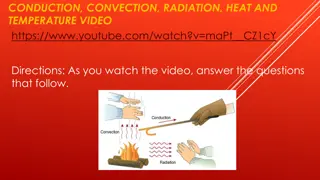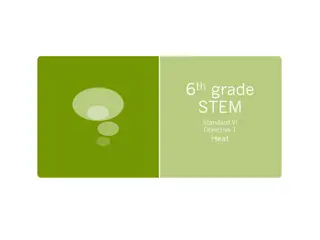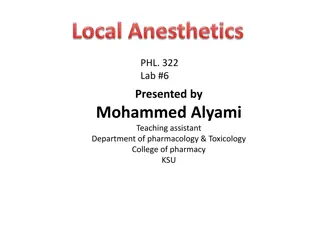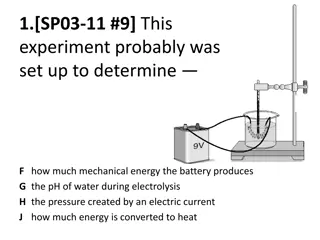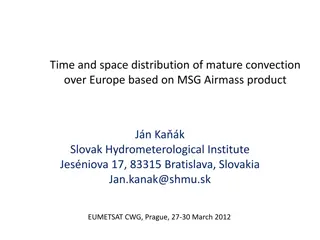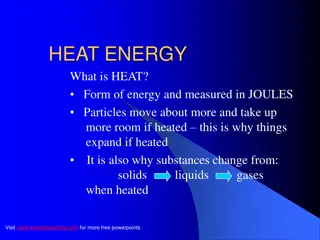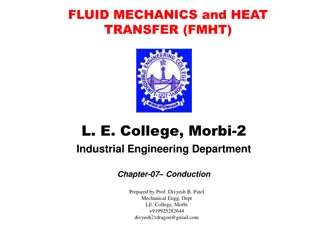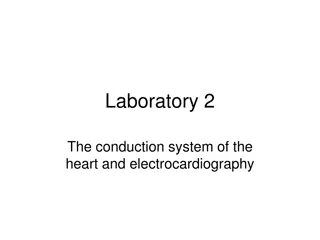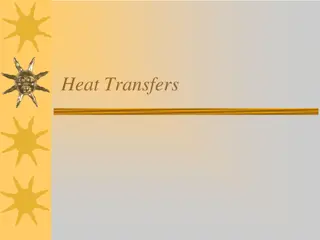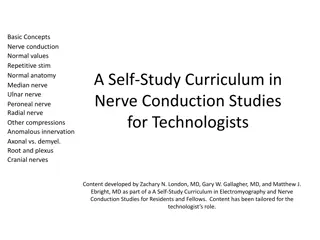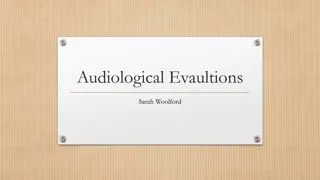ECE 305 Electromagnetic Theory
Explore the fundamental concepts of electric fields in material space, covering topics such as free space, conductors, insulators, semiconductors, current conduction, and charge density. Delve into the properties of materials, convection vs. conduction current, and the role of superconductors in ele
7 views • 25 slides
Chapter Two Governing Equations of Heat Conduction
This compilation covers examples and governing equations of heat conduction, including boundary conditions and scenarios involving one-dimensional conduction in various structures. It explores scenarios like steady-state conditions in a plane wall, heat conduction along a pipeline, and temperature d
2 views • 12 slides
Atmospheric Thermodynamics in Second Stage Lecture
Explore key concepts in atmospheric thermodynamics, including condensation level, free convection level, and the use of thermodynamic diagrams. Learn about the process of condensation, stability levels in the atmosphere, and the significance of free convection in weather patterns. Discover why therm
0 views • 27 slides
Convection Currents in Earth's Systems
Convection currents refer to the movement of heat by fluids like liquids and gases, transferring heat from one place to another. They play a significant role in the geosphere, atmosphere, and hydrosphere of the Earth, influencing phenomena such as plate tectonics, winds, and ocean currents. In the g
2 views • 12 slides
Cooking Methods: Conduction and Convection Explained
Cooking methods like conduction and convection are fundamental in culinary arts. Conduction involves direct heat transfer through matter, while convection utilizes the movement of fluids for heat transfer. Gravity and buoyancy play crucial roles in natural convection processes, resulting in efficien
7 views • 45 slides
Transient Conduction in Thermal Energy Storage Units and Cylinders
Explore examples of transient conduction phenomena in thermal energy storage units, cylinders, and spheres. Learn how to calculate time durations, temperature changes, and energy removal rates during these heating and cooling processes. The examples cover scenarios involving aluminum slabs, oil bath
2 views • 10 slides
Heat Energy Transfer and Principles
Heat energy is the result of particle movement in solids, liquids, and gases. It can be transferred through conduction, convection, and radiation. Conduction occurs through direct contact, convection involves the movement of fluids, and radiation transfers heat through empty space. Understanding how
3 views • 14 slides
Heat Conduction Through Hollow Spheres in Dairy Engineering
Dr. J. Badshah, a University Professor cum Chief Scientist at Sanjay Gandhi Institute of Dairy Technology, explains the conduction through hollow spheres with varying thermal conductivity. The concept of logarithmic mean area for hollow spheres and solving numericals related to conduction through a
3 views • 6 slides
Heat Transfer: Conduction, Convection, Radiation
Explore the concepts of conduction, convection, and radiation in heat transfer through an engaging video. Learn how thermal energy is transferred through solids, liquids, and gases, and understand the role of insulation in preventing heat transfer. Discover why hot water rises and cold water sinks,
2 views • 5 slides
Heat Transfer in Science
Investigate and understand the movement of heat between objects through conduction, convection, and radiation. Learn to compare materials that conduct heat with insulating materials, describe heat transfer processes, and design experiments to study heat energy movement. Explore the use of ratio reas
5 views • 31 slides
Convection Currents Lab Activity
Engage students in a hands-on lab activity to observe convection currents in action. The agenda includes bell work about convection, a hypothesis on confetti paper movement in hot water, detailed lab procedures, drawing conclusions with CER format, and thought-provoking conclusion questions related
4 views • 7 slides
Local Anesthesia and Nerve Conduction Blockade
Local Anesthetics (LAs) are drugs that abolish sensations like pain in specific body areas by blocking nerve conduction of sensory impulses. This process involves reducing the influx of sodium ions, preventing membrane depolarization, and inhibiting action potential conduction. LAs are weak bases wi
2 views • 22 slides
Heat Transfer in Scientific Experiments
Explore various scientific experiments related to heat transfer, including determining energy produced by batteries, heat convection in gases and liquids, detecting warmth through a door, energy transformations in the Earth system, and optimizing solar heaters. Learn about conduction, convection, ra
0 views • 16 slides
Mature Convection Distribution Over Europe
Analyzing the time and space distribution of mature convection over Europe based on MSG Airmass product from Slovak Hydrometeorological Institute. The data covers various timeframes and processing steps, highlighting the dependence on Sun elevation, daytime hours, and monthly variations. Statistical
1 views • 11 slides
Heat Energy Transfer and Conduction in Materials
Heat energy is a form of energy measured in joules that causes particles to move faster, expand, and change states. Learn about the difference between heat and temperature, heating and cooling processes, and the methods of energy transfer such as conduction. Discover how materials conduct heat diffe
0 views • 18 slides
Heat Transfer: Conduction, Convection, and Radiation
Heat transfer is a fundamental process that occurs through conduction, convection, and radiation. Conduction involves the transfer of heat between particles through direct contact, while convection moves heat within fluids and gases through currents. Radiation is heat transfer through electromagneti
5 views • 13 slides
The Conduction System of the Heart and Electrocardiography
This laboratory focuses on the conduction system of the heart and electrocardiography, covering topics such as the anatomy of the internal conduction pathway, normal electrocardiogram interpretation, and the role of autorhythmic cells and pacemakers. The content also includes information on electrod
4 views • 16 slides
Heat Transfer Methods and Insulation
Explore the various methods of heat transfer such as conduction, convection, and radiation, along with the roles of conductors and insulators in managing heat. Discover why metals feel cool to the touch, how insulated containers work, and the mechanism behind a Thermos. Delve into the concepts of co
2 views • 14 slides
Electrical Concepts in Nerve Conduction Studies
Exploring the fundamental electrical properties in nerve conduction studies, including charge, voltage, current, and impedance. Learn about normal values, anatomy, and anomalies in nerve function. This self-study curriculum is designed for technologists interested in electromyography and nerve condu
2 views • 73 slides
Heat Conduction and Transfer in Thermal Systems
Explore the fundamental concepts of heat conduction and transfer, including Fourier's law, steady-state conduction, thermal resistance, multi-layered systems, cylindrical objects, and overall heat transfer coefficients. Discover how to analyze boundary conditions, calculate critical insulation thick
6 views • 20 slides
Extended Surface Heat Transfer in Thermal Fluids Laboratory
This laboratory explores heat transfer in a single cylindrical extended surface (a fin) under free and forced convection to understand fin effectiveness and influencing parameters. Various types of fins like rectangular, triangular, annular, and pin fins are discussed, along with primary modes of he
0 views • 19 slides
Heat Transfer: A Comprehensive Overview
Heat transfer is a fundamental concept in physics, where energy moves from hot to cold objects through conduction, radiation, and convection. Heat is not a substance but a form of energy that speeds up molecules. Conduction transfers heat between substances in direct contact, while convection involv
11 views • 13 slides
Audiological Evaultions
Basics of hearing testing including audiometry, audiometers, transducers, and key terminology such as monaural, binaural, unilateral, bilateral, and within normal limits. Learn about air conduction and bone conduction testing methods, as well as the significance of pure tone testing in determining h
7 views • 17 slides
Introduction to Conservation of Momentum in Fluid Dynamics
Explore the fundamentals of the Navier-Stokes Equation, incompressibility condition, heat flow equation, dynamics of convection, and the Boussinesq Approximation. Learn about the setup for convection in a box and the finite difference simulation of convection, along with terms like vector notation a
0 views • 67 slides
Forced Convection – Internal Flow
This document delves into the principles of forced convection internal flow in mechanical engineering, covering hydrodynamic and thermal considerations, empirical correlations, and practical applications. It explores the unique features of boundary layer development, energy balances, and convection
2 views • 29 slides
Introduction to Heat Transfer and Thermodynamics
Delve into the fundamental concepts of heat transfer and thermodynamics, understanding the difference between them and how they relate. Explore topics such as conduction heat transfer, one-dimensional conduction, and three-dimensional heat conduction equations. Gain insights into the thermal conduct
3 views • 23 slides
Heat Transfer and Energy Sources
Explore the mechanisms of heat transfer through Earth's system, including radiation, conduction, and convection. Learn how density variations cause movement in the atmosphere, water, and rocks, and understand the role of solar radiation in heating Earth. Discover how energy is transferred by radiati
2 views • 10 slides
One-Dimensional Steady State Conduction Examples - Part I
In this resource by Dawit M., you will find examples related to one-dimensional steady state conduction, focusing on scenarios like plane wall heat loss with convection and radiation, composite wall heat loss, and more. The examples involve calculating thermal resistances, heat loss rates, and deter
0 views • 7 slides
Heat Transfer Methods and Effects
In Fluid Mechanics and Heat Transfer, heat moves through conduction, convection, and radiation. Conduction transfers heat via direct contact between particles, while convection involves heat transfer within fluids and gases due to particle movement. Understanding these processes explains why metal f
0 views • 13 slides
Heat Transfer Mechanisms
Heat transfer involves the movement of heat from hot to cold regions through conduction, convection, and radiation. Conduction refers to heat transfer within materials, while convection involves the transfer of heat through fluids and gases. Understanding these mechanisms helps explain why metal fee
3 views • 36 slides
Unveiling Convection Currents in Earth's Mantle
Dive into the intriguing world of convection currents, explore how they work, and understand their significance in the Earth's mantle dynamics. Witness the flow of hot and cold substances, discover why hot water rises, and unravel the mysteries of these natural phenomena. Explore the application of
4 views • 7 slides
Current Density in Conduction and Convection Phenomena
Explore the concepts of convection and conduction current density in electromagnetism. Learn how charged particles give rise to current densities, the application of Ohm's law, and calculations involving resistance in conductors. Dive into the intricacies of current flow and conductivity in various
4 views • 6 slides
Heat Transfer and Convection in Engineering
Explore the fundamentals of heat transfer and convection in engineering, covering topics such as boundary layer analysis, convection coefficients, and Newton's Law of Cooling. Gain insights into classifying different types of flows and the importance of local vs. average convection coefficients. Dis
3 views • 12 slides
Differential Equations for Heat Conduction in Different Coordinates
Explore the general differential equations for heat conduction in Cartesian and cylindrical coordinates, along with steady state conditions and Laplace equation. Fourier's law of heat conduction and the thermal diffusivity are discussed, providing a comprehensive overview of heat conduction principl
0 views • 7 slides
Heat Transfer Methods: Conduction, Convection, Radiation
Learn about the three main methods of heat transfer - conduction, convection, and radiation. Understand how heat flows through different mediums and how each method works to transfer thermal energy efficiently.
1 views • 4 slides
2D Steady-State Conduction Examples with Finite Difference Equations
Explore examples of 2D steady-state conduction problems solved using finite difference equations. Example scenarios include heat generation without convection and convection without heat generation, each requiring distinct calculations. Understand temperature distributions, heat transfer rates, and
0 views • 7 slides
Understanding Heat Conduction in Walls and Thermal Transfer Equations
Explore the concepts of heat conduction through walls, Fourier equation, thermal resistance networks, and examples of calculating heat transfer across plane walls. Learn about convection, radiation, and overall heat transfer coefficients in a comprehensive guide.
0 views • 24 slides
Numerical Simulations of Convections and Rayleigh-Bénard Convection Study
Explore the research on numerical simulations of convections conducted by Eleisha Jackson at the University of Arizona, focusing on solving differential equations using MATLAB and the Pseudo-Spectral Collocation Method. The study delves into fluid flow phenomena, specifically Rayleigh-Bénard Convec
0 views • 13 slides
Understanding Heat and Thermodynamics: Conduction, Convection, and Radiation
Dive into the world of energy with this comprehensive guide on heat and thermodynamics. Learn about conduction, convection, and radiation, along with the classification of materials as thermal conductors or insulators. Explore the laws of energy conservation and thermodynamics to understand how ther
3 views • 20 slides
Greenhouse Impact on Heat Loss Mechanisms
Investigate the efficiency of containing a hot object in a greenhouse to reduce heat loss. Explore different heat transfer mechanisms like conduction, convection, and radiation. Understand how a greenhouse traps heat and the role of gases like CO2 in Earth's atmosphere as a greenhouse effect. Conduc
1 views • 14 slides

